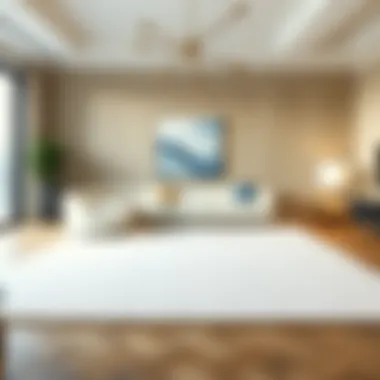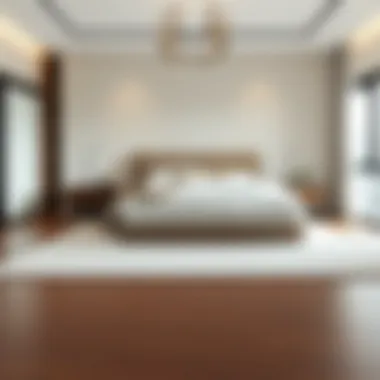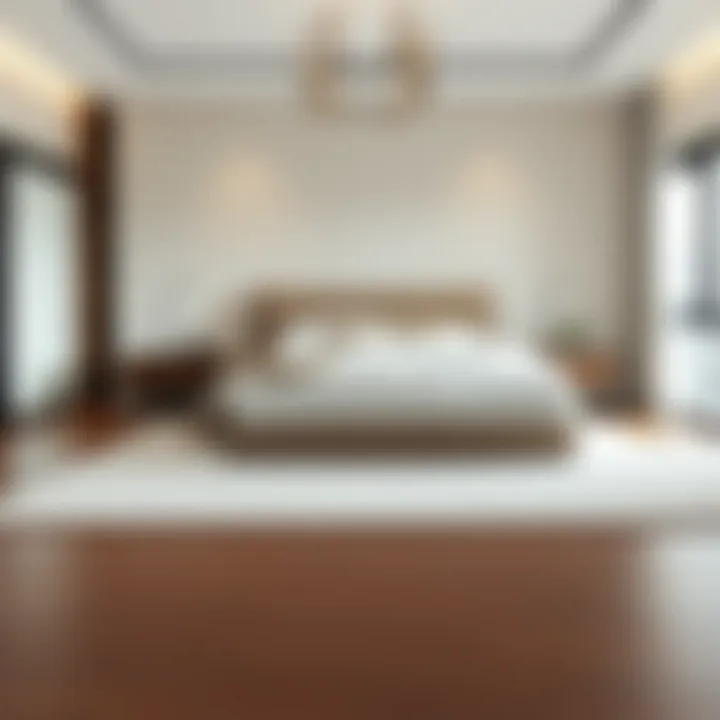Transform Your Space with Large Plain Area Rugs


Intro
In the realm of interior design, few elements hold as much power to transform a space as large plain area rugs. These unsung heroes of decor serve not only as foundational pieces beneath our feet but also act as blank canvases on which the rest of the room is painted. Their significance extends beyond mere aesthetics; they bring warmth, texture, and coherence to any setting. Homeowners and designers alike are continually in search of ways to optimize their spaces. This guide aims to equip them with the insights necessary to wield the immense potential of large plain area rugs.
By understanding the unique qualities that these rugs possess, one can elevate not only the look of a room but also its overall ambiance. From selecting the right size and material to implementing effective maintenance strategies, every decision plays a pivotal role in achieving that desired harmony.
As we delve deeper into this topic, we’ll explore the latest design inspirations and practical advice. Whether you're a homeowner embarking on a refresh or a designer looking for the most effective solutions in your projects, this narrative will serve as your trusted companion in mastering the art of integrating large plain area rugs into your spaces.
Now, let’s unfold the various facets of design inspiration that can act as a guiding light in your journey.
Intro to Large Plain Area Rugs
Understanding large plain area rugs is not just about their aesthetic appeal; it's also about grasping their vital role in home design. These rugs often act as a foundation for your decor, anchoring a space while enhancing its overall elegance and functionality. Selecting the right rug can change the entire mood of a room and contribute to both comfort and style, making it a crucial decision in interior design.
Defining Large Plain Area Rugs
Large plain area rugs are defined by more than just their size; they lack intricate patterns or bold designs, focusing instead on simplicity and richness of color or texture. Generally, these rugs cover substantial areas of the floor and can significantly influence the feel of a room.
These rugs come in different sizes but are typically at least five by seven feet. They can be made from various materials including wool, cotton, and synthetics, tailored to fit any setting from a cozy living room to a formal dining area. Their solid color often acts as a blank canvas on which homeowners can layer furniture and accessories, creating a harmonious look that balances style and comfort.
Historical Context and Evolution
The history of area rugs goes back centuries, originating in various cultures around the world. In traditional settings, rugs served both functional and decorative purposes. As time progressed, their evolution reflected changes in design philosophy and lifestyle choices.
In the early days, large rugs were crafted by hand, often from natural fibers, signifying wealth and sophistication. However, with the development of the industrial age, the mass production of rugs became commonplace. Today, while many rugs are still made by artisans, consumers have a wealth of options, spanning from eco-friendly materials to modern synthetic blends.
This evolution continues to shape how large plain area rugs are perceived. They are not simply floor coverings anymore but are seen as a critical element that ties a room together, providing both comfort and style. The modern understanding of these rugs reflects a blend of cultural appreciation and contemporary design, making them essential in interior spaces.
"A good rug is not just an accessory; it's a foundation that can transform a house into a home."
By examining these rugs through their definitions and historical contexts, we gain deeper insight into their importance in home décor and their ability to marry form and function.
Aesthetic Appeal of Large Plain Area Rugs
The aesthetic appeal of large plain area rugs carries significant weight in the realm of interior design. They serve as essential pieces that link different elements within a space while providing a canvas that can transform the overall atmosphere. A well-selected large area rug can set the tone of a room, drawing attention and offering a feeling of cohesion even in open layouts.
The charm of these rugs often lies in their simplicity. Unlike more intricate patterned rugs, a plain rug can quietly enhance other decor features without clashing. This quality allows homeowners and designers to utilize rugs flexibly, adapting to various styles—be it contemporary minimalism, mid-century modern, or a rustic farmhouse feel. Overall, the aesthetic role that large plain area rugs play should not be underestimated.
Color Schemes and Their Impact
Choosing the right color for a large plain area rug can have a profound effect on the look and feel of a space. Neutral tones such as beige, gray, or white can promote a calming ambiance, making them suitable for busy areas or serene spaces like bedrooms. They can act as a backdrop that helps other colors and textures of furnishings pop. Moreover, when one leans toward a bold color—like deep navy or forest green—it brings a grounding effect to the room, sparking energy while still keeping things balanced because it doesn’t compete with patterns.
It's also worth noting that color can influence mood. Warm colors, like terracotta or ochre, may evoke feelings of coziness, while cooler shades often offer a sense of tranquility. This connection between color and emotion should guide one’s choice in rugs thoughtfully, ensuring they align with the intended atmosphere of the space.
Techniques for Enhancing Space
To maximize the beauty of large plain area rugs, it helps to employ certain techniques that can enhance their presence in a room. Here are two effective methods:
Layering with Textures
Layering textures involves placing rugs of different materials or styles on top of one another. This technique allows homeowners to create a rich visual landscape. For instance, a chunky wool rug layered beneath a smoother jute rug offers not just visual interest but also tactile variety, inviting touch and interaction.
One key characteristic of layering is that it can add depth; it creates a more intimate feel in larger areas. This method works especially well in spacious living rooms, where the plain base rug can stabilize the room's layout while the top rug adds personality.


However, layering requires some care. There’s a risk of overwhelming the space, especially if the chosen textures clash instead of harmonize. As long as that balance is maintained, layering can elevate the aesthetic tremendously.
Contrast with Furniture
Creating contrast with furniture is another impactful way to enhance the aesthetics of large plain rugs. When one pairs a light-colored rug with darker furniture or vice versa, it allows the rug to stand out and become a statement piece. This contrast draws the eye and can highlight the beauty of the furniture itself.
For example, a white or cream rug works wonders under a rich mahogany table or dark leather couch, while a dark rug can provide a beautiful backdrop for lighter furniture pieces. The unique feature here is that contrast naturally defines a space, guiding movement and focus within the room.
However, it's essential to go easy on patterns elsewhere in the room to prevent chaos and confusion. Keeping contextual elements cohesive will allow the contrast to shine without overshadowing other design components.
"The beauty of a plain rug lies in its versatility; it can work anywhere when chosen with care."
In summary, the aesthetic appeal of large plain area rugs is multifaceted. It extends beyond the visual impact alone, reaching into how these rugs can enhance emotional atmospheres through carefully chosen colors and skillful placement with furniture and textures. This foundation sets the stage for a well-curated space that is not only visually appealing but also functionally sound.
Functional Benefits of Large Plain Area Rugs
Large plain area rugs are much more than just decorative pieces; they play a crucial role in the functionality of a space. Understanding their benefits is key for homeowners, designers, and decorators alike. These rugs can help define areas, reduce noise levels, and provide comfort, all of which contribute to creating a coherent and inviting environment.
Defining Spaces within Open Layouts
In modern homes, open floor plans are more popular than ever. However, this design choice can leave spaces feeling vast and unanchored. A large plain area rug serves as a visual anchor, delineating areas like the living room from dining spaces or office nooks. By placing a rug beneath furniture arrangements, you create a sense of belonging and intimacy in an otherwise expansive layout.
- Visual Division: The right rug can visually separate areas without the need for walls or bulky furniture, making it easier to transition from one activity to another.
- Fluidity in Design: You can choose a single color palette for an open space, using a plain rug to tie together different design elements, making it feel cohesive.
- Ease of Movement: Large rugs can enhance the flow of a space by providing a clear pathway for movement, guiding guests effortlessly through your home.
Sound Absorption Qualities
Another often-overlooked advantage of large plain area rugs is their ability to absorb sound. In homes with hard flooring like tile or hardwood, noise can bounce around, creating an echoing effect that feels unwelcoming. Rugs help to dampen these sounds, making for a more serene living environment.
"A soft surface underfoot can transform an echoey room into a peaceful retreat."
- Noise Reduction: This is particularly important in apartment settings where noise can be a concern for neighbors. A thick rug can successfully minimize sound transfer.
- Enhanced Acoustics: Large area rugs can improve overall acoustics in your space, providing a quieter atmosphere for conversations and reducing distractions in shared or family spaces.
- Comfort in Sound: By lessening noise, rugs can also create a more comfortable experience for activities like reading or watching television, which require quiet backgrounds.
Comfort and Warmth Contributions
When it comes to comfort, large plain area rugs shine bright. If you’ve ever walked on a cold tile floor during winter, you know firsthand the difference a rug can make. Generally, rugs add warmth and softness underfoot and can change the overall feel of a room.
- Thermal Insulation: Rugs provide an extra layer of insulation, keeping spaces warmer in colder months, and adding comfort to a hard surface beneath.
- Safety for Children: For homes with kids, rugs can provide a soft area for play, reducing the risk of injuries from falls.
- Inviting Atmosphere: A warm, welcoming environment encourages relaxation; a large rug can effectively create this atmosphere, making your home feel more inviting.
Choosing the Right Material for Large Plain Area Rugs
Selecting the right material for large plain area rugs is a pivotal step in achieving not just aesthetic appeal but also functionality in a space. The material choice essentially dictates how a rug feels underfoot, how it stands up to daily wear, and how easy it is to care for. Given the diverse materials available, knowing the distinctions and the pros and cons can help homeowners and designers make informed decisions that align with their needs and personal styles.
Natural Fibers vs. Synthetic Options
When it comes to large plain area rugs, natural fibers such as wool, jute, and cotton offer a unique warmth and threshold of comfort. Wool, for instance, is celebrated for its luxurious soft texture and durability, making it a long-lasting choice. Jute, on the other hand, provides a more rustic vibe and is often appreciated for its eco-friendliness; it’s a biodegradable material that adds a touch of nature to your home. Cotton is versatile, easy to clean, and comes in vibrant colors, perfect for playful environments.
Conversely, synthetic options like polypropylene and nylon can deliver impressive stain resistance and durability at a lower price point. They are crafted for easy maintenance and can withstand heavy foot traffic, making them suitable for busy households. However, some folks find them less comfortable compared to their natural counterparts. Ultimately, the decision comes down to personal preference and intended use.
"Natural fibers bring a homey touch, while synthetics offer resilience and ease."
Durability Considerations
Durability is a crucial factor that should never be overlooked when choosing a large plain area rug. Natural fibers like wool are inherently resilient; they can handle significant foot traffic without showing signs of wear too quickly. This quality makes them ideal for living rooms and other communal spaces. However, they may require more careful cleaning routines, as natural fibers can absorb stains easily.


On the flip side, synthetic rugs are engineered to be tough, often treated with coatings that resist spills and stains. For instance, a high-quality polypropylene rug can endure daily mishaps with grace. But remember, even the toughest rug has its limits. Considering the specific environment—like whether you have pets or kids—plays a significant role in determining the appropriate material.
Maintenance and Cleaning Needs
The maintenance and cleaning requirements of large plain area rugs vary significantly according to the material selected. Natural fiber rugs often need regular vacuuming to keep dust and particles at bay. Spot cleaning is usually required for stains, and some may recommend professional cleaning once or twice a year to truly keep the fibers in top-notch condition.
Synthetic rugs are generally more forgiving when it comes to messes; most can simply be wiped down or brushed off without much hassle. Many are also machine washable, offering an easy route to cleanliness. Nonetheless, it’s wise to check the manufacturer’s recommendations, as not all synthetic rugs boast this feature.
Maintaining your rug properly not only enhances its lifespan but also keeps the space looking fresh and inviting. In the end, a little effort goes a long way in preserving the beauty of your large plain area rugs.
Placement Strategies for Large Plain Area Rugs
Strategically placing large plain area rugs can dramatically influence the look and functionality of a space. Homeowners and designers need to appreciate the alignment and positioning of these rugs within their interiors, as it shapes both the aesthetic and the practical use of the area. Getting this placement right can harmonize the design, create visual pathways, and even impact the acoustics of a room.
Living Room Arrangements
The living room typically serves as the heart of the home, where families gather and entertain guests. When placing a large plain area rug in this setting, consider the arrangement of the furniture. The rug should extend at least a few inches under each piece of furniture to create a cohesive look. For instance, a large rug can anchor a sofa and armchairs, ensuring that they all sit comfortably upon the same surface. This establishes a unified sitting area, making the space feel inviting and well-considered.
In smaller living rooms, it’s wise to choose rugs that don’t overwhelm the space; lighter colors or understated textures can help maintain the open feel of the room. Conversely, in expansive living areas, opt for a bold or darker tone to create a grounding effect. Remember, the rug shouldn’t just serve a decorative purpose; it should also enhance the flow of movement within the room.
Bedroom Use and Considerations
In bedrooms, a large plain area rug can introduce warmth and comfort underfoot, especially when you first wake up in the morning. When selecting the placement, think about whether the rug should rest beneath the bed or at the foot. If it lies under the bed, ideally, the rug should extend about 18 to 24 inches beyond the bed frame on all sides, allowing for a soft surface to step onto. This creates a look of balance and provides a welcoming touch to each morning.
If positioning the rug at the foot of the bed, ensure it’s wide enough to accommodate nightstands on either side. This allows for coherence in the arrangement of your bedroom while also contributing to the room’s overall feel. Choosing the right material, such as soft wool or durable synthetic fibers, can also affect the comfort level underfoot. Additionally, layering a rug with a textured throw or other decorative elements can add depth to the design.
Incorporating Rugs in Dining Spaces
The dining area often requires a different approach due to the necessity for a stable eating environment. A large plain area rug can complement a table and chairs beautifully but must be chosen carefully to suit the space's function. The rug should ideally be large enough for all chairs to sit comfortably on it, even when pulled out from the table. This prevents awkward moments when guests stand up, ensuring that chairs do not scratch the flooring beneath when moved.
In addition to practical considerations, choose materials that resist staining and are easy to clean. Natural fibers like jute can work well, but also consider synthetic options that can withstand spills. When it comes to color, think about what would suit your dining area; opting for neutral tones can provide versatility, while bolder choices might make a style statement.
"Proper rug placement not only ties a room together aesthetically, but also enhances comfort and functionality."
By being thoughtful about placement strategies for rugs in these key rooms, homeowners can elevate their spaces. Make sure the dimensions of the rug complement the room size, and balance the colors and textures to achieve an aesthetically pleasing environment.
Design Trends Involving Large Plain Area Rugs
Large plain area rugs might seem simple, but their role in modern interior design is pretty significant. They're like the unsung heroes of a room. Not only can they provide warmth and comfort, but they also enhance aesthetics in a way that aligns with the latest design trends.
Contemporary Minimalism
In a world where "less is more" rings true, contemporary minimalism is a design philosophy that puts the focus on simplicity, clean lines, and uncluttered spaces. Large plain area rugs fit perfectly into this trend.
When selecting a rug for a minimalistic space, it's best to go for a solid color that complements the overall color palette of the room. Shades like soft beige, muted grey, or rich navy can ground the space, making it feel cohesive. Opting for high-quality materials like wool or cotton can add warmth without compromising the minimalist ethos.
- Consider Texture: In a mostly minimalistic environment, texture can create a contrast without breaking the design rules. A plush wool rug can create comfort and invite people in.
- Placement Matters: Positioning a rug to anchor furniture arrangements is also vital. A large rug that extends under key furniture pieces can help define the space while keeping the look clean and sophisticated.
"Minimalism is not a lack of something. It's simply the perfect amount of something."
Eclectic Mixing with Patterns
While some lean toward minimalism, others find joy in the unexpected and whimsical charm of eclectic design. The beauty of large plain area rugs is that they can serve as a neutral base in a room filled with colorful patterns and textures. Think about an area with a vibrant patterned sofa or an array of textured cushions; a large, plain rug can serve as a visual anchor.
This trend encourages mixing various styles, which can be a fun challenge. Here’s how to get the balance just right:
- Choose a Color Scheme: Keep the color scheme in mind when selecting the rug. If your room displays lots of warm colors, a warm-toned plain rug can work magic.
- Layering is Key: Don’t hesitate to layer small patterned rugs atop a large plain one to create even more depth. This way, the plain rug maintains a clean look while adding interest with layers.


Sustainable and Eco-Friendly Choices
As sustainability gains traction, homeowners and designers alike are considering eco-friendly materials in their choices. Large plain area rugs can be made from organic fibers, recycled materials, or sustainably sourced resources. Such choices not only contribute to reducing environmental impact but also enhance indoor air quality, making your space healthier.
There are a few things to think about when leaning towards sustainable choices:
- Material Matters: Look for jute, sisal, or organic cotton for natural options. These materials are durable and often biodegradable.
- Production Transparency: Brands with clear sustainability initiatives and transparent production practices should be prioritized. This ensures that your rug isn’t just stylish, but also ethically sourced.
- Investing in Quality: A higher-quality rug will last longer, reducing waste over time. It’s often worth spending a little more upfront for a rug that will not need to be replaced frequently.
Common Misconceptions About Large Plain Area Rugs
When it comes to large plain area rugs, several preconceived notions float around, often clouding the practicality and potential of these decorative pieces. It's essential to dispel these misconceptions because they may prevent homeowners, designers, and decorators from fully utilizing these rugs in their spaces. Understanding the facts behind these myths not only enhances design choices but also contributes to creating a well-balanced and inviting environment.
Beliefs About Size and Space
One of the pervasive beliefs surrounding large plain area rugs is that they overly dominate smaller spaces. Some think that introducing a sizable rug into a compact room can cramp its style, making it feel suffocating rather than cozy. However, this perspective misses a crucial understanding of layout and design.
In reality, a large rug can unify different areas within a room, creating a coherent aesthetic. A well-chosen rug serves as a visual anchor, especially in open-concept layouts. It helps to delineate spaces such as the living and dining areas while often enhancing depth.
Here are several points to consider regarding size and space with large plain area rugs:
- Proportion Matters: Aim for a rug that complements the furniture size, freeing the space rather than congesting it.
- Color Choice: Opting for lighter colors can trick the eye, making the area feel more expansive.
- Layering Options: Layering rugs can add dimension and warmth instead of overwhelming the area.
In many cases, the proper use of a large rug increases comfort and invites movement around the space. Think of it as a way to string together different elements within a room, just like how a beautiful necklace highlights an outfit.
Durability Myths
Another common myth is that large plain area rugs, especially those made from natural fibers, lack resilience and are challenging to maintain. Many assume that the larger the rug, the more likely it is to show dirt and wear, leading to a toss-it-out mentality before exploring restoration or maintenance options.
Large rugs can be surprisingly durable when composed of the right materials and cared for correctly. Many options exist today that balance aesthetics with longevity, including nylon and wool blends. These materials typically resist stains, wear, and even fading from sunlight, if properly selected.
Here are important factors to consider regarding the durability of large plain area rugs:
- Material Quality: Selecting high-quality materials ensures longevity. Wool or synthetic blends may offer the ideal balance of comfort and resilience.
- Regular Maintenance: Simple steps like vacuuming regularly and promptly attending to spills can maintain the rug's appearance and longevity.
- Area-Specific Choices: Different areas of the home can pose distinct challenges; for instance, a dining area rug could use a stain-resistant feature due to food spills.
"A rug isn’t just a decorative layer; it’s a foundational piece that shapes ambiance."
For more insights on choosing the right materials and caring for your rugs, check out this informative article.
Exploring the reality of these misconceptions clarifies how large plain area rugs can enhance both aesthetic and functional aspects of your living spaces, transforming how you think about these integral design elements.
Closure and Final Thoughts
In wrapping up this guide, it’s crucial to emphasize the multifaceted role of large plain area rugs in enhancing interior spaces. Through this exploration, we've uncovered how these rugs not only serve as aesthetic focal points but also contribute significantly to the functionality of a room. They can define areas, provide warmth, and absorb sound, making them indispensable in both residential and commercial settings.
The thoughtful selection of a large plain area rug—considering factors like color, material, and placement—can greatly elevate your interior design. The right choice can harmonize a space, tying together different elements while standing out as a statement piece.
Recap of Key Insights
- Aesthetic Appeal: Large plain area rugs offer versatility in design. With various colors and materials, they can complement any room style from minimalist to eclectic.
- Functional Benefits: Beyond looks, they offer practical advantages. These rugs help segregate spaces in open layouts, provide comfort underfoot, and reduce noise—a vital factor in urban living.
- Material Matters: Choosing the right material is crucial. Natural fibers like wool or cotton often meet durability and maintenance needs better than synthetic options, providing longevity to your investment.
- Placement Strategies: Where and how you place these rugs matters. In the living room, placing a rug under furniture can create an intimate, cohesive atmosphere. Similarly, in dining areas, it can prevent sliding of chairs and enhance the dining experience.
Encouragement for Thoughtful Selection
As you venture into selecting a large plain area rug, take a step back and assess your space holistically. Ask yourself: What vibe do I want to create? Is this rug functional for my lifestyle? Consider the traffic in your home—if you have pets or kids, durability should be high on your priority list.
On top of that, don’t shy away from experimenting. Color choices can evoke specific feelings; for instance, a soft beige can infuse serenity, while a bold navy can add depth. Before finalizing, perhaps try out smaller samples as visuals in your room before committing to a purchase.
Remember, large plain area rugs can revolutionize a space, adding both elegance and comfort. Don’t rush; your choice should feel right not just for aesthetics but also align with your everyday life.
"The floor is the stage for your decor. Don’t let it be bare. Choose wisely, and let your rug tell your style story."
For additional guidance, homeowners can explore resources like Wikipedia, Britannica, or community discussions on platforms like Reddit to further enrich their understanding of how to select the perfect large plain area rug.



